What is the Window on the Ceiling Called?
As natural light becomes a priority in modern home design, ceiling windows are gaining popularity among self-builders and homeowners. Whether you refer to them as roof windows, skylights, or rooflights, these ceiling windows offer both aesthetic and functional benefits, such as flooding spaces with daylight and improving the overall atmosphere of a home. This guide will explore the various types of roof windows, key elements that impact their performance, and the terminology used within the industry.
What the different Names for the Ceiling Window?
Ceiling windows are known by several names, and the terminology can vary depending on the context and regional preferences. Here’s a breakdown of the most common terms and their subtle differences:
- Skylights: Most commonly used to describe windows installed on pitched roofs with a slope of 15-75 degrees. Skylights are typically fixed or operable and are designed to bring natural light into attics, lofts, or upper floors.
- Flat Roof Skylight: This term is used interchangeably with “flat roof rooflight” to describe windows installed on flat roofs with a pitch of 0-15 degrees. They are designed to bring daylight into spaces below, such as extensions or rooms with flat roofs.
- Roof Windows: A term primarily used for operable windows installed on sloping roofs. Roof windows are generally larger and more robust than skylights, featuring stronger frames and hardware. They are often installed in accessible areas like loft conversions.
- Rooflights: Typically refers to windows installed on flat roofs (0-15 degrees pitch). Rooflights can be fixed or operable and are valued for their versatility in modern home design.
- Lantern Rooflight: Commonly found on flat roofs, lantern rooflights are raised structures with glazing bars, often rectangular, that allow light to flood into the space below.
- Pyramid Rooflights: Similar to lantern rooflights but square in shape, pyramid rooflights are also installed on flat roofs and provide a striking architectural feature.
- Modular Rooflights: Also known as multi-panel rooflights, these are larger rooflights that are split into several units. They can be installed on both flat and pitched roofs and are used to maximize daylight in large spaces.
- Conservation Skylight: Designed for historical or conservation areas, these pitched skylights feature glazing bars to maintain the traditional aesthetic.

Types of Windows on Roofs
When choosing ceiling windows for your project, understanding the different types available is crucial to finding the best fit for your space:
- Fixed Rooflights: Designed to provide natural light without the option of opening for ventilation, fixed rooflights are ideal for areas where daylight is needed without compromising insulation. Their simplicity often results in superior thermal efficiency.
- Opening Rooflights: Perfect for spaces that require both natural light and ventilation, these rooflights can be manually or electronically operated, allowing for easy control of airflow. They are a great choice for maintaining indoor air quality while enjoying the benefits of daylight.
- Modular Rooflights: Ideal for large, continuous areas of glazing, modular rooflights are often used in commercial settings or modern homes that seek to maximize daylight. They can be customized in various sizes and configurations to suit different architectural needs.
- Walk-On Rooflights: Designed for areas where the skylight is part of a walking surface, such as terraces or balconies. These rooflights are built to withstand foot traffic while still allowing light to filter through, combining functionality with aesthetics.
- Lantern Rooflights: Often installed in orangeries or extensions, lantern rooflights add architectural interest while flooding the space below with natural light. Their raised design makes them a standout feature in any room.
- AOV (Automatic Opening Vent) Rooflights: Critical for smoke ventilation and compliance with building regulations, AOV rooflights automatically open in the event of a fire to provide a safe escape route. They are an essential component of any building’s safety system.
- Access Rooflights: Designed to provide easy access to the roof for maintenance or as an entrance to a roof terrace, access rooflights are functional while also providing natural light.
- Pitched Skylights: Specifically designed for sloped roofs, pitched skylights offer excellent water drainage and improved thermal efficiency, making them suitable for a wide range of roof pitches.

Key Elements of Rooflights
When considering the addition of a rooflight or skylight to your home, it’s essential to understand the key elements that can impact performance, energy efficiency, and overall satisfaction. Here are the crucial points to keep in mind so you can make an informed decision when purchasing.
- Upstands: An upstand is a crucial component that enhances thermal efficiency, weatherproofing, and structural support. At EOS, our rooflights come with an insulated upstand as standard. This not only improves the thermal performance of the unit but also simplifies the installation process, particularly for self-builders.
- Pitching Flat Roof Rooflights: To avoid water pooling and the potential for leaks, flat roof rooflights should be installed with a minimum pitch of 5 degrees. This slight angle ensures proper water drainage and helps extend the lifespan of the rooflight.
- Energy Efficiency: It’s essential to select rooflights that have been rigorously tested and can provide a reliable system U value—a measure of the rooflight’s overall insulation effectiveness. Opting for rooflights with low U values ensures reduced heat loss and improved energy efficiency in your home.
- Glazing Options: The choice between double and triple glazing has a significant impact on energy efficiency. Triple glazing offers superior insulation compared to double glazing, reducing heat loss and making it an excellent choice for energy-conscious homeowners.
- Ventilation: Incorporating opening rooflights into your design can provide natural ventilation, which is key to maintaining a healthy indoor environment. This feature is particularly beneficial for homeowners looking to improve indoor air quality by reducing moisture levels and preventing the buildup of indoor pollutants.

FAQ
What is the difference between a skylight and a roof window?
While both terms describe windows installed on roofs, skylights are typically used for pitched roofs and may be fixed or operable, whereas roof windows are generally larger, operable, and installed on sloping roofs, often in accessible areas like lofts.
How do rooflights improve energy efficiency?
Rooflights improve energy efficiency by reducing the need for artificial lighting during the day and, in the case of operable models, by providing natural ventilation that helps regulate indoor temperatures. Choosing rooflights with low U values and high-performance glazing can further enhance your home’s energy efficiency.
Can rooflights be installed on any roof type?
Yes, rooflights can be installed on a variety of roof types, including flat, pitched, and even curved roofs. The key is to select a rooflight that is compatible with your roof’s design and pitch. For instance, flat roof rooflights should be installed with a slight pitch to prevent water pooling.
What is the installation process for rooflights?
The installation process for rooflights varies depending on the type and location of the rooflight. However, selecting rooflights with an integrated upstand can significantly simplify the installation, particularly for self-builders, by providing a ready-made base that ensures a perfect seal against the elements.
Final Considerations of Ceiling Windows
Ceiling windows, whether referred to as skylights, roof windows, or rooflights, offer a versatile solution for enhancing natural light and ventilation in your home. For self-builders and homeowners, choosing the right type of rooflight and understanding the key elements involved in their design is essential for achieving the desired results. EOS Rooflights, with their integrated upstands and high-performance glazing options, provide an ideal solution, combining ease of installation with superior thermal efficiency. Explore EOS Rooflights to find the perfect rooflight for your next project.
Contact our team
If you have any questions, would like a bespoke price or want to enquire about our installation service. Give us a call or drop an email:
![]() 0208 462 3557
0208 462 3557



